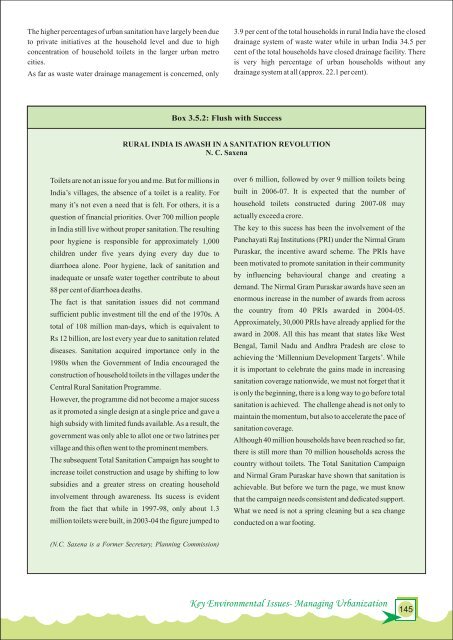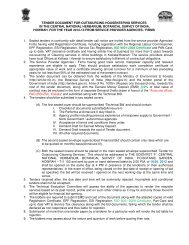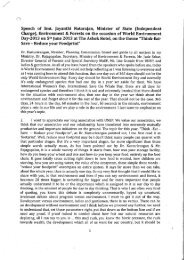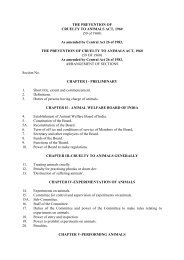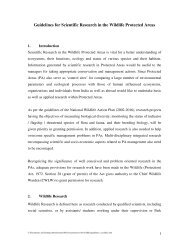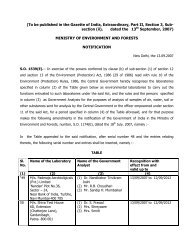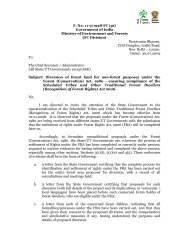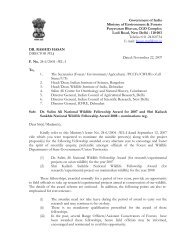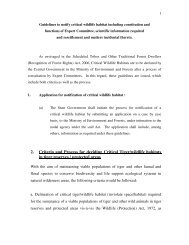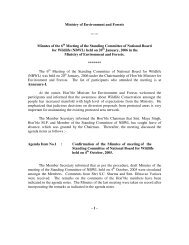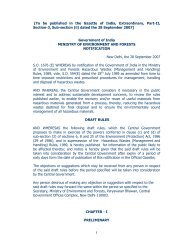lR;eso t;rs - Ministry of Environment and Forests
lR;eso t;rs - Ministry of Environment and Forests
lR;eso t;rs - Ministry of Environment and Forests
Create successful ePaper yourself
Turn your PDF publications into a flip-book with our unique Google optimized e-Paper software.
The higher percentages <strong>of</strong> urban sanitation have largely been due<br />
to private initiatives at the household level <strong>and</strong> due to high<br />
concentration <strong>of</strong> household toilets in the larger urban metro<br />
cities.<br />
As far as waste water drainage management is concerned, only<br />
Toilets are not an issue for you <strong>and</strong> me. But for millions in<br />
India’s villages, the absence <strong>of</strong> a toilet is a reality. For<br />
many it’s not even a need that is felt. For othe<strong>rs</strong>, it is a<br />
question <strong>of</strong> financial priorities. Over 700 million people<br />
in India still live without proper sanitation. The resulting<br />
poor hygiene is responsible for approximately 1,000<br />
children under five yea<strong>rs</strong> dying every day due to<br />
diarrhoea alone. Poor hygiene, lack <strong>of</strong> sanitation <strong>and</strong><br />
inadequate or unsafe water together contribute to about<br />
88 per cent <strong>of</strong> diarrhoea deaths.<br />
The fact is that sanitation issues did not comm<strong>and</strong><br />
sufficient public investment till the end <strong>of</strong> the 1970s. A<br />
total <strong>of</strong> 108 million man-days, which is equivalent to<br />
Rs 12 billion, are lost every year due to sanitation related<br />
diseases. Sanitation acquired importance only in the<br />
1980s when the Government <strong>of</strong> India encouraged the<br />
construction <strong>of</strong> household toilets in the villages under the<br />
Central Rural Sanitation Programme.<br />
3.9 per cent <strong>of</strong> the total households in rural India have the closed<br />
drainage system <strong>of</strong> waste water while in urban India 34.5 per<br />
cent <strong>of</strong> the total households have closed drainage facility. There<br />
is very high percentage <strong>of</strong> urban households without any<br />
drainage system at all (approx. 22.1 per cent).<br />
RURAL INDIA IS AWASH IN A SANITATION REVOLUTION<br />
N. C. Saxena<br />
However, the programme did not become a major sucess<br />
as it promoted a single design at a single price <strong>and</strong> gave a<br />
high subsidy with limited funds available. As a result, the<br />
government was only able to allot one or two latrines per<br />
village <strong>and</strong> this <strong>of</strong>ten went to the prominent membe<strong>rs</strong>.<br />
The subsequent Total Sanitation Campaign has sought to<br />
increase toilet construction <strong>and</strong> usage by shifting to low<br />
subsidies <strong>and</strong> a greater stress on creating household<br />
involvement through awareness. Its sucess is evident<br />
from the fact that while in 1997-98, only about 1.3<br />
million toilets were built, in 2003-04 the figure jumped to<br />
(N.C. Saxena is a Former Secretary, Planning Commission)<br />
Box 3.5.2: Flush with Success<br />
over 6 million, followed by over 9 million toilets being<br />
built in 2006-07. It is expected that the number <strong>of</strong><br />
household toilets constructed during 2007-08 may<br />
actually exceed a crore.<br />
The key to this sucess has been the involvement <strong>of</strong> the<br />
Panchayati Raj Institutions (PRI) under the Nirmal Gram<br />
Puraskar, the incentive award scheme. The PRIs have<br />
been motivated to promote sanitation in their community<br />
by influencing behavioural change <strong>and</strong> creating a<br />
dem<strong>and</strong>. The Nirmal Gram Puraskar awards have seen an<br />
enormous increase in the number <strong>of</strong> awards from across<br />
the country from 40 PRIs awarded in 2004-05.<br />
Approximately, 30,000 PRIs have already applied for the<br />
award in 2008. All this has meant that states like West<br />
Bengal, Tamil Nadu <strong>and</strong> Andhra Pradesh are close to<br />
achieving the ‘Millennium Development Targets’. While<br />
it is important to celebrate the gains made in increasing<br />
sanitation coverage nationwide, we must not forget that it<br />
is only the beginning, there is a long way to go before total<br />
sanitation is achieved. The challenge ahead is not only to<br />
maintain the momentum, but also to accelerate the pace <strong>of</strong><br />
sanitation coverage.<br />
Although 40 million households have been reached so far,<br />
there is still more than 70 million households across the<br />
country without toilets. The Total Sanitation Campaign<br />
<strong>and</strong> Nirmal Gram Puraskar have shown that sanitation is<br />
achievable. But before we turn the page, we must know<br />
that the campaign needs consistent <strong>and</strong> dedicated support.<br />
What we need is not a spring cleaning but a sea change<br />
conducted on a war footing.<br />
Key <strong>Environment</strong>al Issues- Managing Urbanization<br />
145


